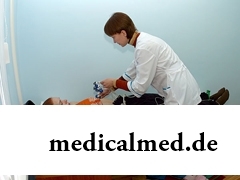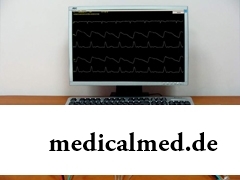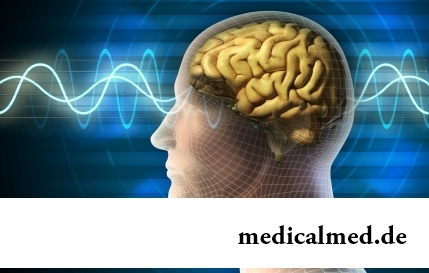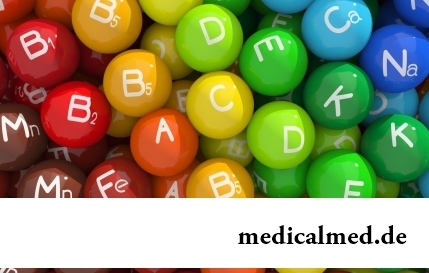





Reografiya
Definition of a reografiya: short description
 Reografiya — a diagnostic method at which the blood stream both in specific bodies and fabrics, and in all organism in general is investigated. The essence of a reografiya consists in graphic registration by means of the special device Yo — a reograf — the changes of electric conductance of body caused by pulse fluctuations of a blood flow.
Reografiya — a diagnostic method at which the blood stream both in specific bodies and fabrics, and in all organism in general is investigated. The essence of a reografiya consists in graphic registration by means of the special device Yo — a reograf — the changes of electric conductance of body caused by pulse fluctuations of a blood flow.
Among all structures of our organism blood has the highest electric conductance. It means that during systolic reduction of heart when blood flows in nearby bodies, electric conductance of these body parts will be high, and at the time of relaxation of a cardiac muscle (diastole), opposite — low. On the basis of indications of a reograf the curve of pulse fluctuations called reogrammy is removed.
Reografiya advantages
Reografiya — a noninvasive method that means harmless to an organism. Really: no intervention in its work happens. Skin and fabrics are not injured, the electric current passed through them has so small size and frequency that it is simply not capable to cause any notable damage.
Harmlessness — not the only advantage of a reografiya. This method has high sensitivity. Reografiya allows to estimate the general condition of blood supply, to reveal blood supply disturbance as separate body, whether it be a brain, kidneys or a liver, and all organism.
What represents a reograf?
Reograf basis — the generator of electric current and a nozzle for transfer of the taken measurements in a graphic form. Reogramma registers by means of the metal electrodes imposed on target body parts. Before a reografiya between an electrode and a body surface of the patient place the fabric laying impregnated with chloride sodium solution (it will improve their mutual contact), and wipe skin with spirit solution to remove a fatty film.
What can be seen on a reogramma?
Reogramma has a sinusoid appearance with more steep slope characterizing an arterial blood stream and smooth descent which, in turn, is display of a venous blood-groove. Thoroughly to analyze a condition of a blood-groove, when carrying out a reografiya it is necessary to remove a set of such curves. The experienced doctor-diagnostician will pay attention to a curve regularity (similarity between several curves) and its form, existence and quantity of additional curves in a declining phase. So, for example, at vegeto-vascular dystonia and arrhythmias the next curves happen different in a form.
 In addition to performance external curves, the doctor solves some more mathematical problems: the reografichesky index for which a certain interval at which exit out of limits it is possible to judge existence of pathology, and some more indicators (an amplitude-frequency indicator, an indicator of venous outflow, a transmission time of pulse wave) is established is calculated by special formulas.
In addition to performance external curves, the doctor solves some more mathematical problems: the reografichesky index for which a certain interval at which exit out of limits it is possible to judge existence of pathology, and some more indicators (an amplitude-frequency indicator, an indicator of venous outflow, a transmission time of pulse wave) is established is calculated by special formulas.
Central reografiya: cardiac performance under magnifying glass
The central reografiya — a blood-groove research in a pulmonary artery and an aorta — an excellent way to estimate work of your heart. On a krovenapolneniye of easy and right ventricles judge a condition of sokratitelny function of heart. Normal the reogramma of a pulmonary artery looks as follows: the flat ascending part (on an aorta reogramma this piece more abrupt), a round top with small "dimple" or an additional wave and smooth descent. When carrying out the central reografiya allocate the following types реограмм depending on a condition of a blood-groove in heart and lungs:
- hypervolemic (the increased blood-groove volume). It is reflected higher sharp-pointed curve with the abrupt descending part in a reogramma;
- hypovolemic (the reduced blood-groove volume). Height of a curve decreases, on its ascending part appears "notches", top — the flat, descending part takes more flat form;
- hypertensive (supertension in vessels of lungs). The curve has the steep slope, round top and flat descent.
Reografiya of vessels
Reografiya of vessels or a reovazografiya allows to estimate a blood stream in vessels on the periphery, that is in extremities. Main "targets" of a reovazografiya — vessels of a shoulder of a forearm, a brush (upper extremities), hips, shins, feet (the lower extremities). Reografiya of vessels is carried out by the same way as it was described above: rectangular or tape electrodes are used, leather under them is processed by solution of sodium chloride or special electroconductive gel. To investigate a blood stream on some certain site (a shoulder, a shin, etc.) one electrode impose at the beginning of this site, and another, respectively — in its end. For example, if to speak about a shin, then the area of an ankle joint and a popliteal space will be these points.
The wave on a normal reogramma has the abrupt ascending part, the round top and flat descent with possible additional waves. By means of a reografiya of vessels it is possible to make, for example, such diagnosis as an obliterating endarteritis, or as it is called still, "the smoker's leg": a chronic disease at which arteries of a shin and foot are surprised. It is reflected in a reogramma in decrease in height of a curve, flattening of top, lack of additional waves.
Thus, if there are premises or suspicions on malfunctions with peripheral vessels (loss of their tone, elasticity, narrowing of a gleam or even obstruction), then the reografiya of vessels will be able to give the answer to the concerning questions.
Caries is the most widespread infectious disease in the world to which even flu cannot compete.

Deciding to get rid of an addiction, not all imagine what effects it is necessary to face. Process of refusal from ку...
Section: Articles about health
The brain of the person is studied not one hundred years, but the quantity of the riddles connected with this body increases rather, than decreases. Perhaps, numerous delusions concerning a structure and functioning of a brain, many are explained by it from...
Section: Articles about health
Musicotherapy – a treatment method which caused and causes a set of a controversy concerning its efficiency. However the facts are relentless: during the numerous researches curative impact of music on an organism was scientifically confirmed. Since then in a number of the countries the technique is included complex therapy of diseases of cardiovascular and respiratory system, dorsodynias and a backbone, psychosomatic disturbances and many other illnesses. The musicotherapy in a pedi is especially widely applied...
Section: Articles about health
The stroke is one of the most widespread diseases of the person, annually in the world about 6 million cases эт are registered...
Section: Articles about health
The dietology, as well as other sciences, does not stand still. Food stuffs are exposed to comprehensive study, and scientists obtain new information on their properties and influence on a human body. Unfortunately, this reasonable and natural process from time to time д...
Section: Articles about health
Sugar - the digestible refined product which is not of special value for an organism of the modern person. The use of sugar in food is based rather on the psychological dependence caused by desire to indulge itself with something tasty, and further and the biological, caused need of an organism for glucose as a result of big emissions of insulin in blood. Such circulation of insulin and glucose with continuous increase in portions of sugar is rather offensive and can become the reason for a narusha...
Section: Articles about health
What woman does not dream of a beautiful and thick hair? So far physicians developed difficult schemes on hair transplant, in the bet industry...
Section: Articles about health
Vitamin complexes belong to the most popular drugs, probably, in our country there is no person who was not hearing about advantage of vitamins and never their accepting. The more vitamins, the better, we consider and as it appeared, cruelly we are mistaken. So l...
Section: Articles about health
The immunity role in growth of the child is invaluable. The proteins-immunoglobulins produced by immune system preserve the child against the diseases capable − owing to an organism weak still − to serve as a stressful factor, to become the reason of many complications and delays in development of the kid. If the immune system weakened, health of the child is under direct threat and needs active actions for strengthening of protective forces of an organism − preferably non-drug....
Section: Articles about health
Life of the modern woman is very difficult. Opportunities to realize itself are wide: it not only education and career, but also most differently...
Section: Articles about health
EKO, or extracorporal fertilization - a method of treatment of infertility which became the reason of a set of broken-down copies in due time accused the people working on its creation neither more nor less of rivalry good luck. Already very few people deny the rights...
Section: Articles about health
All got used long ago that, having addressed the plastic surgeon, it is possible to modify natural parameters of a figure or to minimize the damages put to appearance with ruthless time. Many people (preferential women) worldwide annually decide on operations such. However there are also much more exotic interventions which are carried out seldom so far and cost expensive very much. We bring the story about the most unusual of them to your attention....
Section: Articles about health
Beauty shop – the place which is associated only with positive emotions: joy, pleasure, relaxation. One...
Section: Articles about health
The metabolism at each person proceeds in own way. However between the speed of this process and disposal of excess weight after all all have a dependence. Unfortunately, the people inclined to try on itself numerous "miracle" diets, not always at...
Section: Articles about health
Ability of an organism to resist to adverse environmental factors (to impact of temperature drops, humidity and pressure, to the attacks of causative organisms, etc.) directly depends on what the person eats. Business here not only in that cells of a body received a necessary set of nutrients, vitamins and microelements. Scientists established that such components which are capable to influence negatively immune system, in connection with also are a part of foodstuff...
Section: Articles about health
Impossibility to conceive the child – a trouble of many Russian families. During quite long time was considered that the main "culprits...
Section: Articles about health
There comes the season of issues. Many Russians already dream of outdoor recreation, trips, beautiful seaside beaches. At this time there is no wish to think of problems with health and other unpleasant things, however there are subjects which require attention. Summer...
Section: Articles about health
Scientists always aimed to offer fundamental explanations for medical problems. Their theories formed the basis of modern methods of treatment of the hardest pathologies and helped to save a set of lives. However stories are known also such theoretical constructions, following to which brought to mankind of a trouble and torture, ruined destinies and health of many people....
Section: Articles about health
Summer in the heat. Many are going to spend vacation abroad. Travelers the tender seas, rest on beaches wait, for survey достоп...
Section: Articles about health
The endocrine system carries out extremely important role in a human body, practically all processes of life activity are regulated by it. Closed glands (hemadens) produce special biologically active agents – hormones which then o...
Section: Articles about health
Small appetite at the child – the complaint which pediatricians should hear practically from each mother. Most often it is carried to the category of children's whims, however the refusal of food in certain cases can be to alarming symptoms therefore it cannot be ignored....
Section: Articles about health
Venereal diseases in medicine are called the infections which are transmitted preferential sexually, now they are so...
Section: Articles about health
Urogenital candidiasis (milkwoman) – a fungal infection which annoys unpleasant feelings in the field of generative organs, being followed by white curdled allocations, an itch, discomfort during an urination, pain. She is called by Candida fungus – a mustache...
Section: Articles about health
Stability of a hormonal background is one of the most important conditions of preservation of health of the woman. At the same time endocrine system – the thin device extremely sensitive to any external influences. Changes of a way of life (for example, a diet), emotional stresses, infectious diseases, reception of some drugs can become the reason of hormonal failure. Besides, work of hemadens has the natural specifics in certain moments of life: on various St...
Section: Articles about health
According to World Health Organization, every third inhabitant of Earth has excess weight, and every tenth suffers ожирен...
Section: Articles about health
Heart disease and blood vessels lead to disturbance of blood supply of bodies and fabrics that involves failures in their work, deterioration in health of the person, decrease in its working capacity and standard of living. Annually such perishes from pathologies more...
Section: Articles about health
For anybody not a secret that the modern person eats not as his ancestors. For the last 100 years in broad access there were absolutely new products which are result of use of the latest technologies in food production. Significantly ways of storage and transportation of food ingredients changed, and people of the whole world had an opportunity to regularly use those products about which their grandfathers and grandmothers did not even know....
Section: Articles about health
